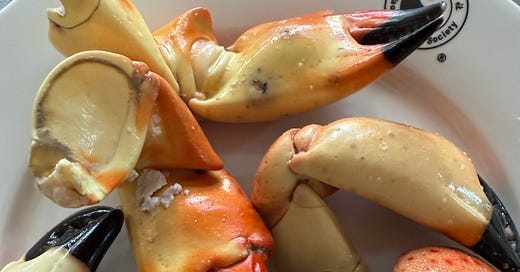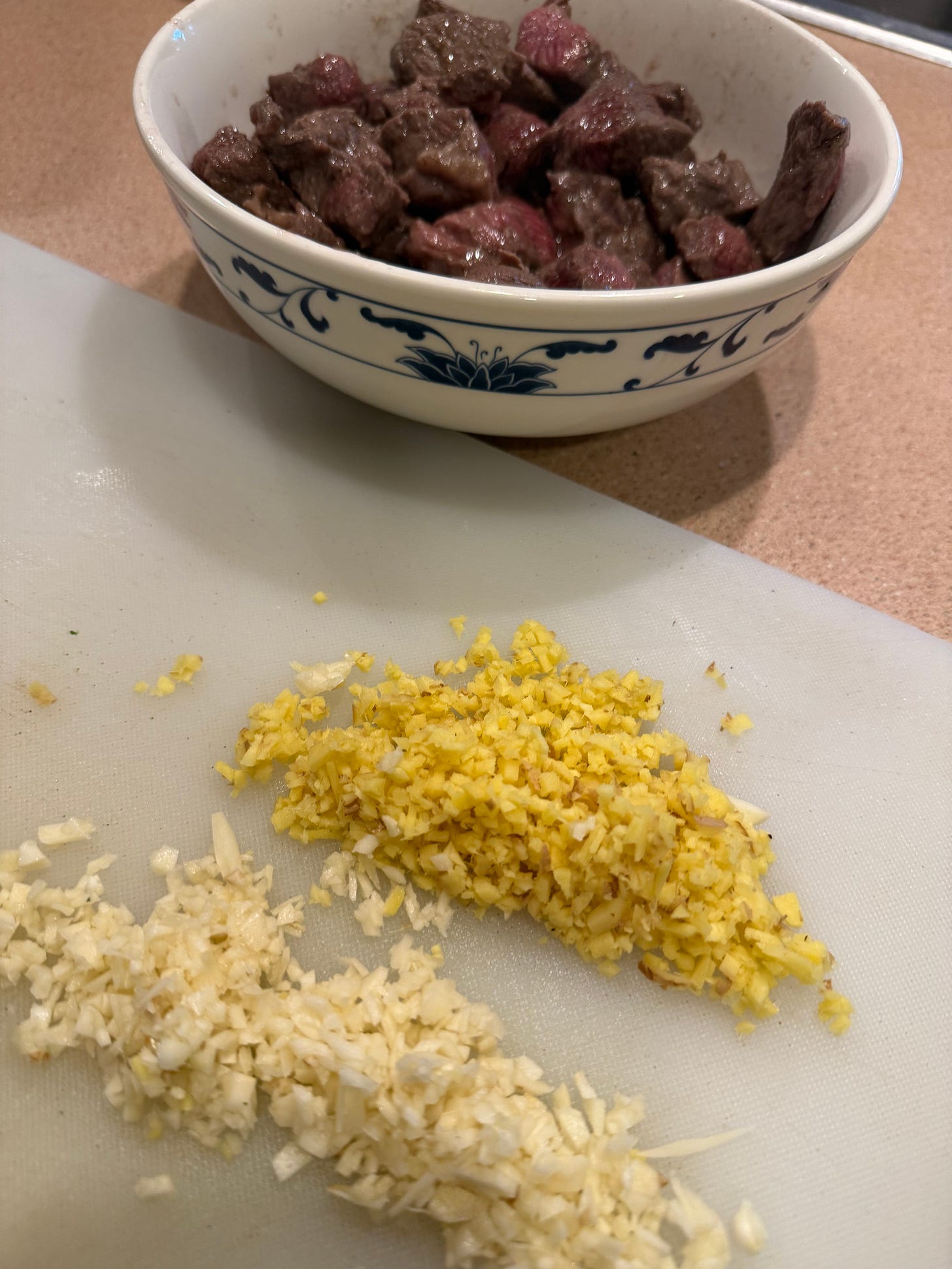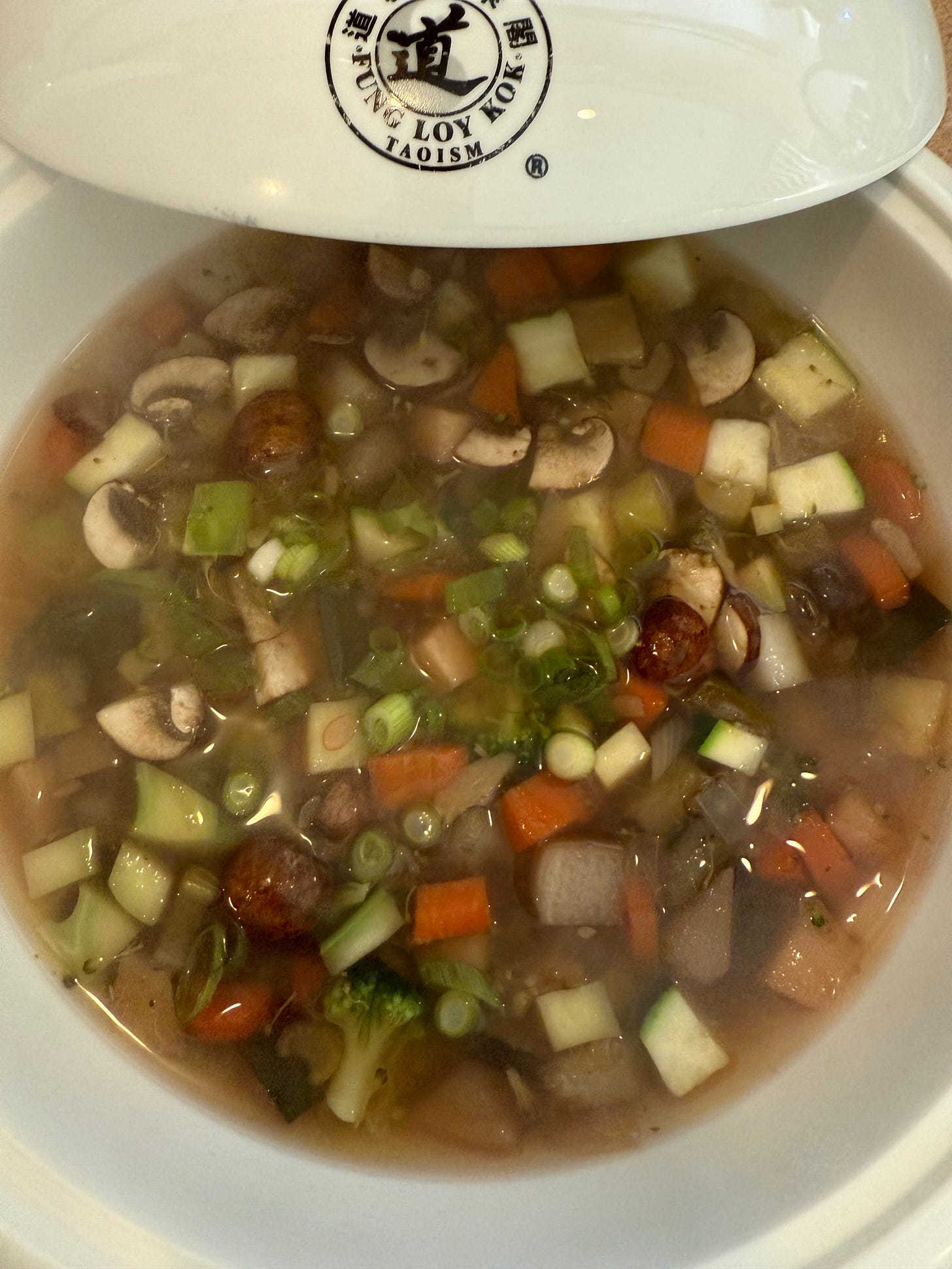No, this hasn’t become the Department of Soup newsletter. Yes, I did also publish a recipe last week for soup (a beloved Turkish lentil soup you’ll find here). No, I’m not sharing another soup recipe because we had two snowstorms at home in New Hampshire last week and the temperature dipped below -0°F again. (According to our local Daybreak newsletter, this is the 10th time this winter the mercury has dipped so low, which is 8 times more than normal.) In fact, I’m writing this week’s soup newsletter from sunny Florida, where the weather has been north of 80°F.
I’m in Dunedin, Florida, to be more specific, at the headquarters of the Taoist Tai Chi Society of the USA for a five-day retreat. In addition to practicing tai chi, while I’m here I’m cooking meals, lunches and dinners, for the 13 national directors and other leaders of the organization in attendance, of which I am one.
Usually, we either fend for ourselves or they order in meals for the leadership group. Just up the road from our center is a small fish store (more like a shack) called Jensen brothers, where in season I’m want to grab a pound or two of stone crab claws for lunch and sometimes also for dinner.
Funnily enough and quite unexpectedly, banqueting is an integral part of my preferred form of exercise and self improvement, the Taoist Tai Chi® internal arts. The attention to detail, complexity, and care for others that are fundamental to the traditional Chinese banquet were considered by our organization’s founder, the late Taoist monk Master Moy Lin Shin, to be and excellent expression and practice of the Taoist arts. In the more than 50-year history of the Taoist Tai Chi Society, as in my life, cooking and banqueting have played an important role.
Volunteering is also an important part of our practice, a way to open your heart and deepen the benefits of your tai chi. Instructors aren’t paid. Everyone pitches in to tend to the administration. For banquets we do all the cooking, serving, and dishwashing ourselves.
In addition to having played many different volunteer roles—including local branch leader, PR director, event planner, social media coordinator, website developer, instructor, and national director—somehow I’ve managed to stay out of the kitchen.
Until now.
For this retreat, I offered to oversee meal production for the leadership group, who meet over meals during retreats. Our campus here in Dunedin includes a bungalow where a few of us are staying that has a very well appointed kitchen. In order for our menus for the week to be consistent with the food served at other sites of the organization, especially the international headquarters of our parent organization, the Fung Loy Kok (FLK) Institute of Taoism near Orangeville, Ontario, some of the other cooks shared their “recipes” with me.
I put recipes in quotation marks because what I got were a few narrative emails about doing this and that without much specificity of amounts, times, or other details. In keeping with the nature of Taoism and tai chi, ours is primarily a tradition of practice with some oral reinforcement thrown in—we learn by doing and reflect on that learning by articulating how things feel. I could imagine standing in the kitchen with someone being shown how to make these dishes, and then being left on my own to figure out the details for myself—which is not dissimilar to how our tai chi training goes.
Among those recipes was this vegetable soup, a recipe so simple, I was skeptical of its appeal. Basically, you peeled and otherwise prepped a bunch of vegetables, saving those peels and trimmings to make stock. Into that stock you put the various vegetables in a particularly order to assure their proper doneness and seasoned it before serving. I wasn’t convinced this simple soup would amount to much beyond the flavor of vegetable cooking water.
I was wrong.
In the typical Taoist Tai Chi fashion, this soup is deceptively simple and more than the sum of its parts. Don’t be put off by the long list of ingredients. You can make it with whatever vegetables and trimmings you have on hand as long as you include some distinctive aromatics, like parsnips and/or parsley. I had turnip and daikon and broccoli and zucchini and mushrooms, so in they went. You can make the stock in advance, but you shoudn’t cook the vegetables until just before you serve it or they turn to mush. (I learned this first hand.) If that happens, before serving, cook a few more fresh vegetables in it for texture and additional flavor.
If you are particular about how you make this soup, paying attention to its subtleties and details, the result is clean and fresh with an underlying complexity that makes it appealing and moreish, like Taoist Tai Chi itself.
RECIPE: FLK Vegetable Soup
Makes 8 servings
3 medium carrots
1 large onion
1 small parsnip
1 medium turnip
1 head broccoli
Handful parsley stems
1 bay leaf
2 stalks celery
1 3-inch piece of daikon, peeled and diced
1 medium zucchini, diced
6 ounces mushrooms, sliced
1 tablespoon soy sauce
Sea salt
Freshly ground black pepper
Honey, maple syrup, or sugar, to taste
2 green onions, chopped
Rinse all the vegetables well. Prep them saving the peels of the carrots, onion, parsnip and turnip. Place the peels in a stock pot. Peel the stems of the broccoli, removing any leaves, and place the peels and leaves in the stock pot, as well. Add the parsley stems the bay leaf, and the leafy tops of the celery to the stock pot, along with any other vegetable scraps you have around. Fill the pot with cold water and set over high heat. Bring to a boil, reduce to a simmer, and let cook 30 minutes or so to make a good stock.
Meanwhile, dice the carrots, onion, parsnip, turnip, and celery and gather together in a bowl or plastic bag. Dice the daikon and broccoli (stems, florets, and all) and set aside. Combine the diced zucchini and sliced mushrooms and set them aside together.
Once the stock has finished simmering and taken on a nice, deep color, strain out the peels into a clean soup pot. Bring back to a boil. Season with a generous pinch of salt and the soy sauce. Once boiling, add the cartons, onion, parsnip, and turnip and let cook about 10 minutes to soften. Add the daikon and broccoli and let cook another 5 minutes. Finally add the zucchini and mushrooms, a generous amount of black pepper and a tablespoon or so of honey or other sweetener. Turn off the heat. Taste and adjust the seasoning. Divide the soup into serving bowls and garnish each with some chopped green onion.






